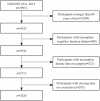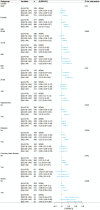Association between dietary copper intake and cognitive function in American older adults: NHANES 2011-2014
- PMID: 40624281
- PMCID: PMC12234787
- DOI: 10.1038/s41598-025-09280-9
Association between dietary copper intake and cognitive function in American older adults: NHANES 2011-2014
Abstract
This cross-sectional observational study examined the association between dietary copper intake and cognitive function in American older adults, using data from the 2011 to 2014 National Health and Nutrition Examination Survey (NHANES). Analyzing a total of 2420 participants, dietary copper intake was determined by averaging two 24-h dietary recalls, whereas cognitive function was assessed by the Digit Symbol Substitution Test (DSST), the Animal Fluency Test (AFT), a Consortium to Establish a Registry for Alzheimer's disease (CERAD) subtest and global cognition Z score. Multivariate linear regression models were used to explore the association between copper levels and cognitive function. Higher copper intake was associated with higher cognitive scores. In the fully adjusted model, compared to the lowest quartile (Q1), the highest quartile (Q4) of copper intake was associated with related to higher cognitive scores (DSST: β = 3.80, 95% CI 1.90,5.70; AFT: β = 1.23, 95% CI 0.48,1.99; CERAD-IRT: β = 0.58, 95% CI - 0.06,1.22; CERAD-DRT: β = 0.47, 95% CI 0.15,0.80; Z score: β = 0.20, 95% CI 0.10,0.29), particularly in participants with a history of stroke. Multivariate smooth spline analysis revealed that dietary copper intake was related to DSST, AFT and Z score in an inverted L-shaped nonlinear manner. The inflection point of copper was 1.63 mg/day for DSST, 1.42 mg/day for AFT and 1.22 mg/day for the Z score. Further longitudinal research is necessary to substantiate these findings.
© 2025. The Author(s).
Conflict of interest statement
Declarations. Competing interests: The authors declare no competing interests. Ethics approval: The National Health and Nutrition Examination Survey (NHANES) is conducted by the Centers for Disease Control and Prevention (CDC) and the National Center for Health Statistics (NCHS). The NCHS Research Ethics Review Committee reviewed and approved the NHANES study protocol. All participants signed written informed consent. Consent for publication: The authors have no ethical, legal, and financial conflicts related to the article. All authors read and approved the manuscript for publication.
Figures



Similar articles
-
Non-linear association between dietary fiber intake and cognitive function mediated by vitamin E: a cross-sectional study in older adults.Front Nutr. 2025 Jul 2;12:1611162. doi: 10.3389/fnut.2025.1611162. eCollection 2025. Front Nutr. 2025. PMID: 40672427 Free PMC article.
-
Caffeine Intake and Cognitive Function Among US Adults Aged 60+: Insights From NHANES 2011-2014.J Hum Nutr Diet. 2025 Aug;38(4):e70090. doi: 10.1111/jhn.70090. J Hum Nutr Diet. 2025. PMID: 40619845
-
Vitamin C intake and cognitive function in older U.S. adults: nonlinear dose-response associations and effect modification by smoking status.Front Nutr. 2025 Jun 4;12:1585863. doi: 10.3389/fnut.2025.1585863. eCollection 2025. Front Nutr. 2025. PMID: 40535041 Free PMC article.
-
Donepezil for dementia due to Alzheimer's disease.Cochrane Database Syst Rev. 2018 Jun 18;6(6):CD001190. doi: 10.1002/14651858.CD001190.pub3. Cochrane Database Syst Rev. 2018. PMID: 29923184 Free PMC article.
-
Cross-sectional and longitudinal associations between adherence to Mediterranean diet with physical performance and cognitive function in older adults: A systematic review and meta-analysis.Ageing Res Rev. 2021 Sep;70:101395. doi: 10.1016/j.arr.2021.101395. Epub 2021 Jun 19. Ageing Res Rev. 2021. PMID: 34153553
References
-
- Zhang, X.-X. et al. The epidemiology of Alzheimer’s disease modifiable risk factors and prevention. J. Prev. Alzheimers Dis.8, 313–321 (2021). - PubMed
Publication types
MeSH terms
Substances
LinkOut - more resources
Full Text Sources
Miscellaneous

